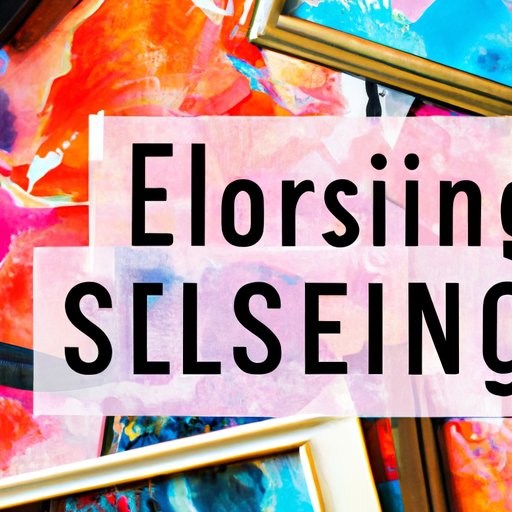Introduction
Selling art online can be a challenge for many artists. Traditional sales channels, such as galleries and exhibitions, can be expensive and may not reach a wide audience. Selling art online provides artists with the opportunity to reach a global audience and connect with potential buyers in a more personal and cost-effective way. This article explores some of the challenges artists face when it comes to selling art online and provides a comprehensive guide to help artists start selling their art online effectively.
A Beginner’s Guide to Selling Art Online
When it comes to selling art online, having an online portfolio is crucial. This portfolio should showcase an artist’s best work, provide detailed descriptions of each piece, and include pricing information. E-commerce sites such as Shopify and Squarespace are great options for artists looking to set up their online store. These platforms offer customizable templates and easy-to-use tools that make it easy to set up an online store.
Creating effective product listings is essential when selling art online. Product listings should include clear, high-quality images of each piece and provide detailed descriptions of the artwork, including its size, medium, and style. Artists should also consider offering multiple payment options and implementing an easy-to-use checkout process to make the buying process as smooth as possible for customers.
Leveraging Social Media to Sell Your Art Online
Social media is an excellent tool for artists looking to reach new audiences and promote their work. By leveraging popular social media platforms such as Instagram, Facebook, and Twitter, artists can connect with potential buyers and build a loyal fan base. Optimizing posts for engagement can help artists gain followers and build brand awareness. This involves posting high-quality images, using relevant hashtags, and engaging with followers by responding to comments and direct messages.
Building an email list is a great way for artists to connect with potential buyers and keep them updated on new pieces available for sale. Artists can build an email list by offering freebies, such as digital downloads or ebooks, or by providing exclusive content or early access to new pieces. Writing effective emails can help close sales and build brand loyalty. Emails should be personalized, engaging, and provide value to the recipient.
Choosing the Right Platform for Online Art Sales
Choosing the right platform to sell art online is crucial for an artist’s success. Different platforms cater to different audiences and offer varying benefits and drawbacks. Marketplaces such as Etsy and Society6 can be great options for artists looking to reach a wide audience. These platforms offer an established user base, built-in payment processing, and marketing tools. Personal websites, on the other hand, provide artists with more control over their branding and product offerings but may require more work in terms of marketing and promotion.
When choosing a platform, artists should consider their goals, budget, and target audience. Researching options and comparing features can help artists select the right platform for their needs.
Pricing Your Art for Online Sales
Pricing art for online sales requires careful consideration of various factors, including materials, size, style, and market demand. Pricing too high can discourage buyers, while pricing too low can undervalue the artist’s work. Artists should consider the pricing of similar pieces on the market and factor in their unique selling propositions to determine a fair and competitive price.
Managing Shipping and Handling for Online Art Sales
Shipping can be a challenging aspect of selling art online. Artwork can be fragile, and ensuring it arrives safely to customers requires careful packaging and shipping. Using protective packaging materials, avoiding glass in frames, and using shipping insurance can help protect artwork in transit. Artists should also communicate shipping times and expectations clearly to customers and provide tracking information to ensure a smooth delivery process.
Conclusion
Selling art online provides artists with a unique opportunity to reach a global audience and connect with potential buyers in a more personal and cost-effective way. By following the tips and strategies outlined in this guide, artists can effectively promote and sell their work online and achieve their goals. Remember to create an online portfolio, leverage social media, build an email list, choose the right platform, price your art competitively, and carefully manage shipping and handling to start selling your art online today.
(Note: Is this article not meeting your expectations? Do you have knowledge or insights to share? Unlock new opportunities and expand your reach by joining our authors team. Click Registration to join us and share your expertise with our readers.)
